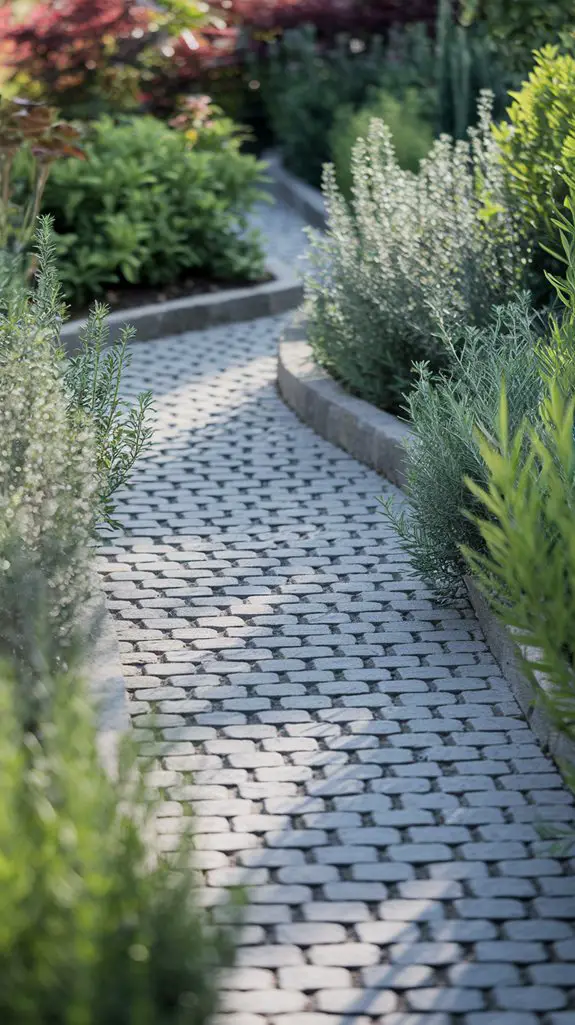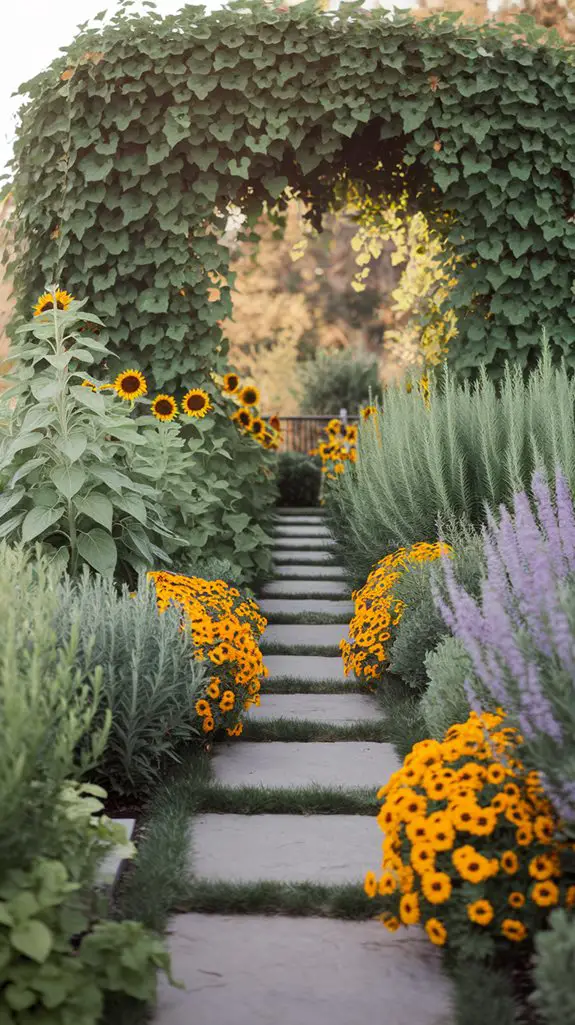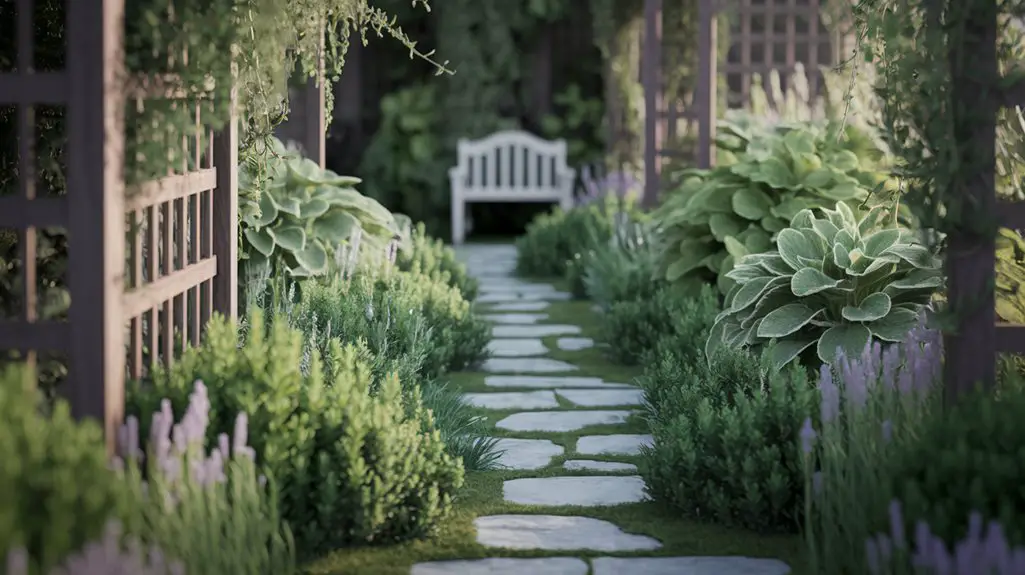You’ll discover that functional herb garden pathways do more than connect different areas—they fundamentally shape how you interact with your plants. Well-designed paths minimize soil compaction, provide essential access for harvesting, and create microclimates that benefit specific herbs. By carefully selecting materials and considering traffic patterns, you’ll establish an ecosystem where both plants and people thrive. The secret to a truly productive herb garden lies in these seemingly simple connecting elements.
Planning Your Herb Garden Pathway Layout
When designing a functional herb garden, the pathway layout serves as both the structural framework and the circulatory system of your garden ecosystem.
Begin by mapping microclimates—noting sun exposure patterns, drainage characteristics, and wind corridors—to optimize herb placement and pathway positioning.
Consider traffic flow frequency; primary routes require wider paths (minimum 36″) with durable materials like flagstone or decomposed granite, while secondary access paths can be narrower (18-24″).
Incorporate nodes at intersections for maintenance access and harvesting stations.
Your pathway network should follow topographical contours to prevent erosion and manage water runoff effectively.
Position moisture-loving herbs (mint, chervil) along lower pathway edges where water naturally collects, and drought-tolerant varieties (rosemary, thyme) at elevated positions with excellent drainage. Additionally, utilizing vertical gardening techniques can enhance your herb garden’s productivity in limited spaces.
Selecting Durable Materials for High-Traffic Herb Gardens

Because herb gardens endure constant foot traffic during planting, maintenance, and harvesting cycles, selecting appropriate pathway materials becomes essential for long-term functionality.
Decomposed granite offers excellent permeability while maintaining stability under pressure, with a pH-neutral composition that won’t affect soil chemistry. For permanent structures, consider tumbled brick pavers (4.5-5.0 on Mohs hardness scale) or flagstone (6.0-7.0 Mohs), both resisting moisture degradation effectively.
Natural mulch materials like pine straw (pH 4.2-4.6) or cedar chips provide temporary pathways while gradually enriching soil through decomposition. These materials require annual replenishment but minimize soil compaction.
For wheelchair accessibility, maintain 36-inch minimum path widths with slopes under 5%, using materials that compact to firm surfaces yet drain effectively during precipitation events. Implementing raised garden beds can also enhance accessibility and improve the overall health of your herb garden.
Companion Planting Along Pathway Borders

Strategic placement of companion plants along pathway borders enhances both the aesthetic appeal and functional efficiency of herb garden designs.
Position alliums and marigolds alongside Mediterranean herbs to repel aphids, while nasturtiums attract predatory insects that consume cabbage moths. Chamomile improves the essential oil content of neighboring basil and mint through mycorrhizal relationships.
For ideal synergy, plant low-growing thyme and oregano directly adjacent to pathways where they’ll release aromatic compounds when brushed, creating microclimates that deter pests.
Intersperse umbellifers like dill and fennel at 24-inch intervals to attract beneficial parasitic wasps. Consider allelopathic compatibility—keep fennel away from coriander, as it inhibits seed formation.
Chives serve as excellent border companions for rosemary and sage, enhancing their pest resistance while requiring minimal moisture competition. Additionally, using companion planting techniques can significantly improve the health and productivity of your herb garden.
Aromatic Herbs That Release Scent When Stepped On
Certain aromatic herbs possess specialized oil glands and fragile cellular structures that release volatile compounds when subjected to physical pressure, making them ideal candidates for strategic placement along garden pathways.
When crushed underfoot, these plants emit their distinctive essential oils, creating an olfactory experience as you navigate your garden.
Thymus serpyllum (creeping thyme) exhibits exceptional durability and releases thymol when compressed.
Chamaemelum nobile (Roman chamomile) offers apple-scented foliage and withstands moderate foot traffic.
Mentha pulegium (pennyroyal) emits potent menthol compounds upon contact.
Corsican mint (Mentha requienii) forms a dense mat exuding intense spearmint fragrance.
Plant these specimens between stepping stones, allowing 4-6 inches between varieties to prevent competition while ensuring continuous aromatic coverage throughout your pathway system. Additionally, incorporating fragrant herb garden ideas enhances the overall sensory appeal of your outdoor space.
Creating Accessible Paths for Harvesting and Maintenance
Well-designed pathways within your herb garden serve dual functions beyond aesthetics, enabling efficient harvesting protocols and sustainable maintenance practices throughout growing seasons. Establish primary paths at 36-48 inches wide to accommodate wheelbarrows and garden carts, with secondary access routes measuring 24-30 inches between herb beds. Incorporate stepping stones placed precisely at 24-inch intervals for natural stride length, allowing you to reach central portions of beds without soil compaction. Select permeable materials like decomposed granite or crushed stone (⅜-inch diameter) that provide 4-6 inches of drainage depth while preventing mud formation. Install 20° sloped paths where terrain permits to facilitate water runoff and reduce erosion potential. Edge pathways with 4-inch aluminum or cedar barriers to prevent herb encroachment and maintain defined maintenance zones. Additionally, incorporating herbs that attract beneficial insects can enhance the garden’s ecosystem and promote pollination.
Integrating Water-Wise Irrigation Systems Along Pathways
Pathways in herb gardens present ideal locations for incorporating efficient irrigation systems that conserve water while maintaining suitable soil moisture levels.
By installing drip irrigation lines alongside your paths, you’ll create a dual-purpose design that delivers precise hydration directly to plant root zones while minimizing evaporation and runoff.
Consider these water-wise pathway irrigation strategies:
- Integrate semi-permeable pathway materials like decomposed granite or spaced pavers that allow excess irrigation water to percolate into the soil rather than becoming runoff.
- Install subsurface drip lines at path edges, positioned 10-15 cm below soil level, delivering water directly to root zones at 2-4 liters per hour.
- Incorporate rainwater harvesting systems that capture precipitation from adjacent structures and redirect flow beneath pathways via perforated pipes. This method enhances your garden’s sustainability by utilizing rainwater collection barrels, allowing for a more efficient water supply during dry spells.
Seasonal Considerations for Year-Round Pathway Functionality
While herb garden pathways may appear static, they experience diverse environmental challenges throughout the year’s changing seasons, requiring thoughtful adaptations to maintain their functionality.
During spring, incorporate permeable materials that efficiently drain snowmelt and rain while preventing erosion of newly sprouted herbs.
Summer demands heat-reflective surfaces—consider light-colored gravel or limestone—to prevent root zone temperature escalation in adjacent Thymus spp. and Rosmarinus officinalis.
For autumn, install strategic drainage channels to prevent pathway flooding from leaf accumulation, which can cause root rot in Mentha and Melissa species.
Winter functionality hinges on proper material selection—avoid terra cotta pavers that crack during freeze-thaw cycles; instead, opt for frost-resistant bluestone or granite.
You’ll need seasonal pathway edging adjustments to accommodate both Perilla frutescens’s summer spread and Artemisia’s winter dieback. Additionally, regular maintenance of raised garden beds can help ensure that the surrounding areas remain healthy and functional throughout the year.
Edible Ground Covers Between Stepping Stones
The strategic placement of edible ground covers between stepping stones transforms pathway interstices into productive microzones within the herb garden ecosystem.
These low-growing species serve dual functions: providing culinary resources while suppressing competitive weeds. Select plants with prostrate growth habits and shallow root systems that withstand moderate foot traffic.
- *Thymus serpyllum* (Creeping Thyme) – Offers aromatic foliage with purple flowers, thrives in USDA zones 4-9, prefers well-drained soil with pH 6.0-8.0
- *Chamaemelum nobile* (Roman Chamomile) – Forms dense mats of feathery foliage, tolerates partial shade, releases apple-scented compounds when crushed
- *Mentha requienii* (Corsican Mint) – Creates a miniature groundcover (1-2cm height), emits intense menthol fragrance when stepped upon, requires consistent moisture
Incorporating these plants into your pathways not only enhances aesthetics but also contributes to edible landscaping ideas that promote sustainability and self-sufficiency in your garden. You’ll find these edible interplantings enhance biodiversity while maximizing your garden’s productive capacity per square meter.
Lighting Your Herb Garden Paths for Evening Harvests
Effective illumination of herb garden pathways extends harvesting opportunities beyond daylight hours, allowing you to gather fresh culinary herbs during evening meal preparation when their volatile oils are often most concentrated.
Install solar-powered bollard lights at 8-10 foot intervals along primary paths, positioning them low (12-18 inches) to minimize light pollution while adequately illuminating plant identification tags.
Choose fixtures with color temperatures between 2700K-3000K (warm white) to prevent disrupting nocturnal pollinators’ behavior patterns. For culinary herb beds, consider installing adjustable LED spotlights with CRI ratings above 90 to accurately render leaf coloration, enabling proper differentiation between similar species like Petroselinum crispum and Anthriscus cerefolium.
Implement motion sensors for less-traveled secondary paths to conserve energy while maintaining accessibility throughout your aromatic landscape. Additionally, consider incorporating bohemian outdoor seating to create a cozy gathering space where you can enjoy your freshly harvested herbs with friends and family.
Conclusion
You’ve now revealed the secrets to functional herb garden pathways. As you implement your design, watch for the microclimatic variations that’ll affect your Thymus serpyllum and Chamaemelum nobile ground covers. Don’t overlook the critical 5-7% slope for proper drainage. What remains? The seasonal transformation—your pathways will evolve from spring’s Mentha pulegium fragrance to winter’s structural Salvia officinalis framework, creating a dynamic, accessible, and productive herbal ecosystem year-round.



